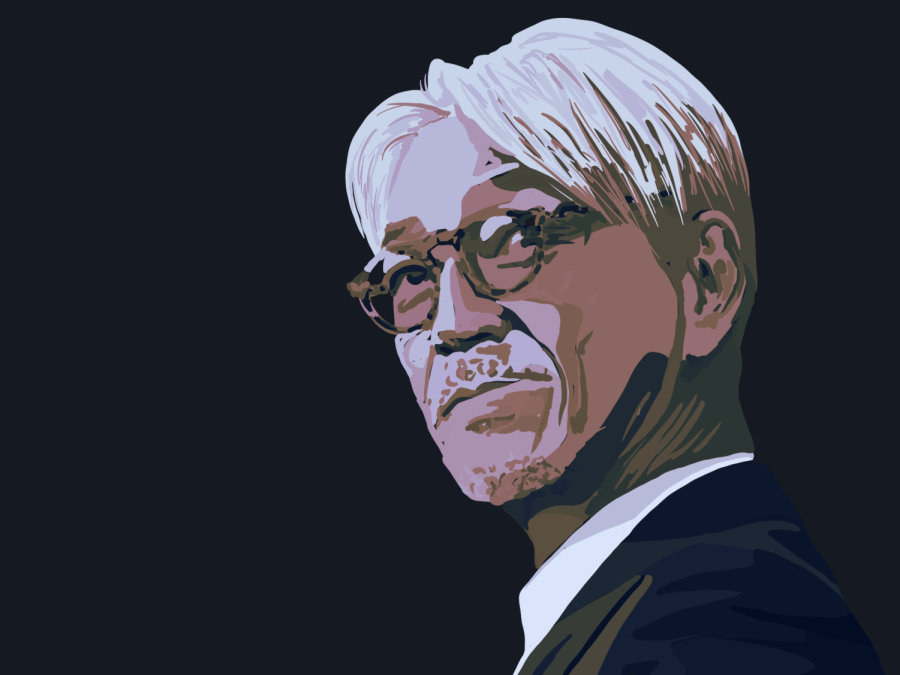Remembering sonic pioneer, cinematic legend and outspoken activist Ryuichi Sakamoto
Ryuichi Sakamoto had one of the most influential runs in the global music industry, establishing himself as an iconic film composer and a luminary in the electro-pop genre.
Remembering the legacy of Ryuichi Sakamoto. (Illustration by Aaliya Luthra)
April 12, 2023
With the recent passing of composer Ryuichi Sakamoto on March 28, generations of fans and artists alike are mourning the loss of a beloved industry legend. While Sakamoto’s nearly decade-long battle with cancer was no secret, his death has sent somber reverberations across the globe.
Having started his music career in the 1970s with the techno trio Yellow Magic Orchestra, Sakamoto cemented himself as a groundbreaking pioneer of experimental electronic music, an award-winning film composer and an outspoken political activist. With a career defined by his persistent push to redefine the sonic boundaries of the music world and reinvent his own sound, Sakamoto represented the unstifled spirit of innovation in the arts.
Sakamoto immersed himself in a multitude of diverse musical influences during his university years. He began his illustrious career with Yellow Magic Orchestra, a band that represents the meteoric rise of synthpop. Along with fellow trailblazers Haruomi Hosono and the late Yukihiro Takahashi, Sakamoto helped craft foundational techno records like the band’s 1979 “Solid State Survivor,” which would leave an indelible imprint on the genre.
In the artist’s solo work, tracks like “Riot in Lagos” have received universal praise for his singular sonic qualities. The Guardian listed the song as one of the 50 key events in dance music history, citing its “otherworldly instrumental that sounds like it’s constantly on the edge of falling apart.”
Throughout his long career in electronic music, Sakamoto would also collaborate frequently with other luminaries in the music world. Whether it was with living legends like Iggy Pop and David Byrne or a newer generation of artists like Thundercat and Yves Tumor, Sakamoto always surrounded himself with unique voices in the industry.
Beyond his pivotal role in the evolution of techno music, Sakamoto is also renowned for his collaborations in the realm of film. The artist is responsible for creating some of the most memorable and distinct soundtracks in silver screen history, having collaborated with the likes of Bernardo Bertolucci, Pedro Almodóvar and Alejandro González Iñárritu.
His first, and arguably most famous, work in film was for Nagisa Ōshima’s wartime drama “Merry Christmas Mr. Lawrence” (1983), which he also starred in as prison camp commander Captain Yonoi alongside David Bowie. After seeing his acting in the rough cut, Sakamoto half-jokingly said in an interview that he wanted to “put beautiful music on top of [his] bad acting scenes.” The result of this collaboration is a timeless piece of film music. Sakamoto’s ambient electronic symphony vividly conveys the film’s themes of clashing cultural values, suppressed desire, human brutality and compassion. Forty years after its release, the film’s theme remains one of his most recognizable and emotionally charged songs.
As a prominent figure in Japanese society, Sakamoto used his platform to advocate for key domestic and international political issues. In the wake of the Fukushima nuclear disaster, Sakamoto aggressively campaigned for the anti-nuclear movement in Japan, saying that it was pointless “to risk our lives for mere electricity.” Despite his declining health due to a cancer diagnosis, Sakamoto continued to host rallies, gatherings and performances, all in the name of denouncing what he saw as an existential threat to humanity. Kyoto-based activist Aileen Mioko Smith pointed out that in Japan, artists “feel that if they speak up about social issues, their careers will be damaged,” yet Sakamoto refused to back down on his principles.
Sakamoto’s drive to create music never dissipated. His 2023 album “12” was recorded during an especially challenging 13-month period when he was diagnosed with rectal cancer, a separate cancer diagnosis that was unrelated to his death. Composed with a piano and synthesizer, each track is minimalistic yet texturally rich — Sakamoto savors every note. Named after the days he recorded each song, the tracks serve as a powerful sonic journal, in which he beautifully articulates his own reconciliation with mortality. After his death, every moment on the album feels all the more heart wrenching. However, it also reminds listeners of Sakamoto’s unrelenting drive to push the boundaries of musical expression.
While the man with his iconic circle-rimmed glasses and silver bowl cut is gone, his indomitable spirit of unyielding progress will forever influence the arts and beyond.
Contact Mick Gaw at [email protected].




























































































































































